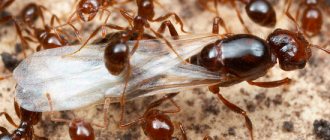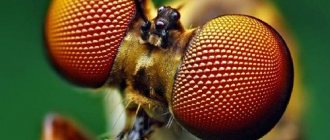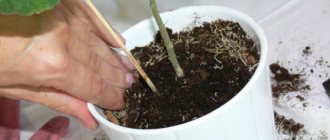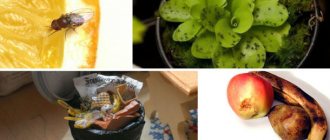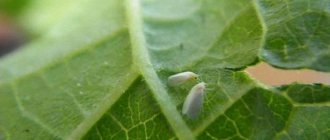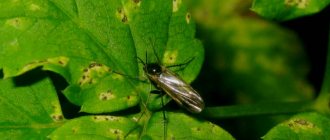Indoor flowers are the joy of every housewife. Thanks to them, comfort and harmony reign in the rooms. And the air is significantly enriched with oxygen. Even regular care of your “green friends” does not guarantee that pests will not infest them. Almost every amateur gardener in his life has encountered such a harmful insect as the flower midge - a small black insect with wings that always catches the eye and irritates with its intrusiveness. If you have midges in your indoor flowers, you will learn how to get rid of them and what products are best to use in this article.
Midges in indoor flowers
Parasites often appear in plants in winter. It is at this time that the plants are weak. When small midges are found in indoor plants, first of all you need to determine to what stage the damage to the flower has reached. Damage is caused both by the insects themselves and their larvae. If you do not immediately resort to any measures, the flower will die.
Initially, it is recommended to dig out the soil in the flower pot and make sure that there are no fly larvae there. After all, getting rid of midges is much easier than getting rid of their larvae.
Varieties of midges in flowers and flower pots
Flower midges can be classified as insects of the Diptera family. They number about 2000 subspecies. Let's list the most common ones.
White midges on flowers - whiteflies, scale insects
White midges , called whiteflies or scale insects , look very similar to aphids. Among indoor plants in pots, soft leaves of fuchsia or begonia are preferred.
White midges on house flowers are whiteflies, also called “scale insects.”
Black midges in flowers - sciarids
Black midges living in home flowers are called sciarids , and another name for these parasites is fungus gnats . They prefer to live near the root system of flowers such as aloe, Decembrist, ficus, azalea. For humans, this type of insect creates considerable inconvenience in the apartment - it gets into food or drink. Settling in the soil where the flower grows, they make it dense and impervious to air, thus causing enormous damage to the roots of the plants.
Black midges on house flowers are called sciarids or fungus gnats
Ground fleas in flower pots - fools
Podura ( ground fleas - white flies ), the second name is springtails . These are jumping wingless parasites. You can see them in places where there is high humidity (the bottom of a pot, a wet tray, the top of the soil of a heavily watered flower). White larvae of podurs cause damage to plant roots. They differ from other parasites in their speed and jumping if someone wants to touch them.
White insects that are found in the soil of home flowers - podras or springtails
Exchange on specialized forums
Register on one of the specialized forums dedicated to plants, or better yet, on several. Each of them has a section for exchange, sale or free gift of home flowers.
If the plant is very valuable, do not hesitate to ask for a reward. Simple plants can be given away for free. Perhaps those wishing to purchase a flower will not respond immediately, but time on the forum will not be wasted. Here you can find friends with similar interests, as well as a lot of information on caring for greenery, based on the personal experience of users, which is especially valuable.
At the same time, it is worth posting on free advertisement sites offers for exchange/donation or sale of excess specimens from your plant collection.
Why are there small midges in indoor flowers?
It is important not to forget that excessively moist soil is the best place for midges to exist and reproduce. So, if you do not want to breed white bugs in the soil of indoor plants, then you should not neglect attention to the soil in pots.
The main source of reproduction of flower parasites is considered to be excess moisture in the soil of indoor flowers.
Secondary reasons for the appearance of harmful insects include:
- Pouring low-quality soil into flower pots. It leads to an invasion of harmful midges, the larvae of which will already live in the soil. As a result, you will need to quickly look for ways to get rid of the emerging parasites.
- The appearance of insects can be facilitated by transplanting plants into huge pots. The soil at the bottom of the flower pot is most saturated with moisture, only the root system of the plant does not reach there. High humidity is a suitable breeding ground for pests.
- The use of organic fertilizers will also encourage the appearance of bugs. Even if the soil is watered moderately, the presence of organic impurities will attract midges, which will settle well on the indoor plant.
- A fly can fly into an apartment from another living space, from the basement, through ventilation or an exhaust pipe. Moreover, the flying insects immediately find suitable flower pots with abundantly moistened soil.
Decorate the entrance
Not only in European, but also in many Russian entrances there are flowers on the windowsills. It is especially good if the room is heated. Then the plants will decorate window sills and walls even in Siberian entrances. Arrange beautifully flowers and sprouts that do not have a place in the house. But don't forget to take care of them. Perhaps this responsibility will be shared by amateur gardeners living nearby.
Label the pots with plants, maybe your neighbors will take the ones you like. This will help them decide.
In summer, if the weather is good, you can display plants at the entrance to the street for the whole day. But not in the hot sun. So some plants will “disappear” and find new owners in just a few hours.
Ways to get rid of midges in house plants
There are many ways to get rid of these harmful parasites - both chemical and folk. To get rid of insects, you should resort to the following measures.
First of all, when flower midges are detected, it is necessary to remove the affected flower away from other plants.
Flower soil in which insects have already settled should be thrown away. The flower is removed from the pot, the root system is washed and the already treated plant is transplanted into disinfected soil. There is an option to replace the top layer of soil.
If it is not possible to change the affected soil, it is recommended to treat it with an insecticide. More effective drugs against flower flies include Fitoverm , Aktara , Tanrek . Flycatcher insecticide , which is available in granules, is also effective in combating annoying midges.
If there are not too many pests yet, then fly sticky tape hung next to the flower pots will help catch them.
If there are already a lot of insects, then it is recommended to use aerosol preparations for destruction, such as Dichlorvos and Raptor . By lightly spraying the product, treat window sills, shelves, and walls located near house plants. Plus, the soil in the flower pot and its bottom. The result of the treatment will be the death of adult individuals and their eggs laid in the ground.
Another good remedy for midges is to reduce the number of waterings of the flower that has been affected by parasites. Dry soil will contribute to the death of the larvae.
Still, the best way to combat midges is to follow all the rules for the care and maintenance of house plants.
Folk remedies for midges in flowers
Midges have appeared in flowers - the problem arises of what means to use to rid your favorite plants of them without harm. One of the ways to independently remove irritable insects is to use various folk remedies.
An effective folk remedy against flies is garlic . The smell of garlic has a detrimental effect on some insects, including flower midges. Just two procedures - and black midges completely die. To prepare the required solution, take three heads of garlic and chop them using a garlic press. The resulting mass is poured with one liter of boiled water. After 4 hours, strain. The leaves of the plants are sprayed with this solution and the soil in the pot is treated.
If soil flies are detected, a solution of potassium permanganate . The soil in the pot is being cultivated. It is recommended to repeat watering the damaged flower after 2 days. In order not to harm the roots of the plant, the solution should be weak.
You can kill flower flies in the soil of a houseplant using soap . To do this, you need to grate laundry soap (20g) and fill it with 1 liter of water. The resulting soap solution is used to treat the leaves and water the soil in the pot.
You can also get rid of flower midges using regular matches . In a pot with a flower, you should deepen about five matches of sulfur into the soil and lightly water the soil. Matches in flowers are replaced every day, as sulfur dissolves in the soil. A certain number of such procedures will rid the plant of both midges and their larvae.
Wood ash is an equally effective folk remedy in the fight against insects on indoor flowers. The soil in the pot is simply covered with such ash and the midges will forever leave the flower they have chosen alone. Plus, wood ash is considered an excellent fertilizer that gives the plant strength.
tobacco helps fight bugs . To prepare the tincture, take 50g of dried tobacco and add one liter of water. Infuses for 2 days. The resulting tincture is sprayed onto the leaves of the flower. The disadvantage is that tobacco tincture has a detrimental effect only on adult insects; the larvae do not die from it.
Ground flies do not like the smell of mint . The edge of the pot can be smeared with the well-known “Star”. This will help get rid of harmful insects.
Celandine tincture (100g of celandine per 1 liter of boiled water) also gets rid of annoying bugs. Treated by spraying plant leaves.
You can also destroy insects in house plants using ammonia . In addition, it improves plant growth. The solution can be prepared by taking 50 ml of ammonia and diluting it in 4 liters of water.
Orange peels also help get rid of harmful insects that attack indoor flowers. The citrus smell irritates them. It is recommended to cover the flower pot with such crusts or to deepen them directly into the soil. The pests will blow away like the wind.
Or you can simply dry the soil . Also an excellent way to combat flower midges. Until the soil is completely dry, it is not advisable to water your “green friend”. Then cover the top of the soil with fried sand and sprinkle it with weak potassium permanganate.
Treatment of infected plants with folk remedies is considered the safest method compared to the use of chemicals.
How do weeds spread?
Many gardeners note that weeds are very tenacious and grow much faster than garden crops. This is due to survivability and the characteristics of the process of reproduction and growth. Some gardeners are upset because despite the constant fight against weeds, they still continue to grow. Even with regular weeding and the use of protective agents.
How weeds spread:
- This is because weeds multiply quickly as a result of being carried by the wind. Tatar and dandelion are transported in this way. In this case, the seeds are carefully attached to a parachute, which flies with the wind.
- With fertilizers. This applies to organic fertilizers such as manure. The summer resident independently introduces weed particles into the garden. Thus, you can grow chicken millet or ashiritsa on your plot. The seeds are covered with a dense shell that is not digested in the intestines of animals. Therefore, it enters the soil in its original form.
- During deep digging. Some seeds are buried quite deep, about 15 cm. In this state, due to lack of moisture and heat, the seeds do not germinate. During digging, the seeds rise upward, so the flow of nutrients improves, and accordingly the seed germinates. By the type of weed you can understand what kind of soil is on the site.
- If wormwood has sprouted in the garden, this indicates excessively dry soil that lacks moisture. Buttercups will sprout if the soil is very moist and if they are over-watered. Plantain usually appears in dense soil that is very heavy and highly acidic. There are several classic methods, including weeding and mulching the soil. These methods are good, but they require a lot of physical labor and time. There are chemical methods of control. However, they can cause deterioration of the soil composition.
Dry wood
Effective insecticides to control midges
But, in some cases, the use of folk remedies only temporarily rids the houseplant of parasites. Time passes, they appear again. Therefore, in order to forget about flower flies forever, it is recommended to resort to the use of chemicals. There are both liquid insecticides, which can be sprayed and watered, and granular ones, intended for mixing with the soil.
It is best to opt for safe drugs. When processing plants, be sure to use personal protective equipment.
The liquid and safest insecticides include “ Agravertin ”, “ Fitoverm ”, “ Fufanon ”, “ Aktara ”, “ Inta-vir ”. These chemicals can be used at home. The course of treatment is carried out over two weeks. Watering the plant is done once a week. After the plant has been watered with an insecticide, it is not advisable to water it with clean water for 5 days.
Dangerous liquid insecticides include Actellik , which has very high toxicity. Its use is prohibited in residential premises.
Granular insecticides include “ Bazudin ”, “ Grom-2 ”, “ Fly-eater ”. The main thing is to mix the granules with the top layer of soil, and not just scatter them on top of the ground. These insecticides do not act as quickly, but they are just as effective as liquid ones.
Do not forget that absolutely all chemicals are toxic. When processing plants, you must wear gloves, safety glasses and a respirator. After work, be sure to ventilate the room.
Bona Forte ), which can paralyze flying pests in an instant, are considered very effective and easy to use Aerosol and spray consist of substances that are harmless to humans and the environment.
How to water weeds with vinegar to make them dry?
Please note that you can use vinegar. Depending on the area that needs to be etched, a 6% solution, as well as concentrated acetic acid, are used.
How to water weeds with vinegar to make them dry:
- Most often, a nine percent solution is used; it is not diluted, but used in its pure form. Treatment is carried out pointwise, when each weed is watered separately. Do not allow drops of the product to fall on garden crops. A 6% solution is also used; it is considered gentle. It is necessary to pour the 6% solution into a liter of water. The amount of solution should be 600 ml.
- The solution is used for spraying. Treatment is carried out once every three days during the week, that is, the total number of treatments should be 2 or 3. It is easiest to spray early in the morning, but on a sunny day. Thus, heating will enhance the effect of the acid, it will work better.
- For plants with a very branched root system, with dense roots, it is necessary to use a stronger solution. For these purposes, 40% acetic acid is used. It is diluted in a ratio of one to one. The resulting solution is used to water the weeds. Please note that vinegar should not be used in beds where there are a large number of vegetable crops. After all, there is a risk of acid getting on the leaves of vegetables.
Similar methods are used in plantings where there are a large number of weeds, but practically no garden or vegetable crops. This is usually an area near a fence or garden paths. Thus, it is advisable to treat with vinegar. Remember that this remedy significantly affects the productivity of the land. Therefore, you should not water the areas where you plan to plant garden crops next year. It is necessary to let the soil rest for approximately 3-4 years so that the concentration of vinegar decreases.
Barrel processing

